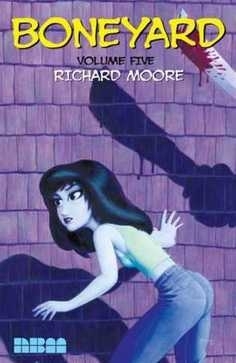Comics /
Comic Reviews /
More Comics
Boneyard Vol. 5
By Zak Edwards
June 22, 2010 - 19:09
You know how the majority of bands can never live up to the early days, that first album or so when they initially broke and took the listening public by storm? While this may be a little different considering this is a single work by Richard Moore rather than an entirely different project, Boneyard is better in volume five than it has ever been. The characters, the humour, the action, the plotting; all of these aspects of this series are better now than since the beginning, displaying a growing maturity and complexity while never sacrificing the essential humour of the series. Maybe it is simply getting to know the characters over these past four volumes (I’ve actually never read the first volume!), but Moore’s work is at its best right here so far, with anticipation for the next only increasing with the quality of this read. A note for those looking for a good book for the young ones, Boneyard may look sort of childish in the art department, given the cartoon influence, but is certainly not in the content, so maybe give this a thorough read through before giving it over to the younger comic enthusiasts. A mainstay of this series is to juxtapose this style of art with some inappropriate humour, something which could be easily overlooked if simply skimmed.
 |
And this book should not be skimmed as Moore’s ability to simultaneously build large jokes while placing plenty of little witticisms and laughs in between can only be properly enjoyed in multiple readings, all the while building a fairly dramatic story which reveals much about the supporting cast. The story follows its familiar formula, with a main plot and subplot coming together in the end, this time with multiple climactic battles. Admittedly, one is longer and more dramatic than the other (and it makes sense, I would rather watch a vampire go against a giant chain-saw murderer rather than a normal guy hit a weird wispy man with a pumpkin for a head!). There is a fair amount of emotion dealt with in this issue as well, but never at the cost of keeping the entertainment level high. The story starts with a football game with most of the cast, which is a light-hearted start to the story filled with plenty of gags, all of which are funny. Taking off from there, following Abbey the vampire on a mission to solve some murders at a camp while the rest are left to their own devices. Abbey’s solo adventure, of sorts, is fun; a combination of murder mystery and secret spy, as Abbey infiltrates a camp to catch a chain-saw murderer is filled with a surprisingly little jokes about kids camps. Instead, the story is more reliant on the tension built through multiple murders and suspects. Unfortunately, Moore decides to go the action route very early on, leaving the mystery in favour of an extended action sequence. The story suffers through the reliance on a fairly easy out, rather than relying on storytelling ability to create something better and more character driven. However, the sbplot with Jack more than makes up for this indiscretion.
Jack is the aforementioned Pumpkin headed man who puts the rest of the cast minus heir and normal human Paris to sleep. It is in these sleeping moments some of the best parts of this volume occur, as the inner fears of the supporting cast are revealed in dream sequences. These dream sequences are almost universally interesting, but special attention needs to be brought to Nessie’s husband, Brutus. Brutus, a mute Frankenstein’s Monster type character, has been used mostly as an emphasis to Nessie’s sexually promiscuous behaviour, but this sequence provides a little window into his inner workings. I don't want to ruin the dream for those about to read the volume, but this is fairly revealing and provides an easy window into the workings of a character fairly unable to express himself. All of the four sequences are spectacular. Ralph the werewolf has one dependent on a mysterious past, while Nessie's drums up her origin story, but both are revealing and interesting in their own ways. Finally, Hildy the witch has one which is interesting as well, if only slightly more generic in concept. These sequences are the meat of this volume, helping add to the depth of the series while the main plot provides the humour and action Boneyard is known for.
Also, this volume is the first I have encountered which is as the comic was first published in black-and-white. A slight mix-up in previous publishing also means the last issue of the previous volume is in this volume as well, allowing for a direct comparison between the coloured and black-and-white issues. I have to say, being introduced to the series in colour has probably made me more prone to one over the other, but recognizing the strength of Moore’s inks, the series doesn’t seem to suffer in the switch. The inks are very well done, something of importance when doing black and white, but if your prefer coloured, not much is lost. I usually enjoy these as they were originally intended, but this is more a matter of preference. Of course, the coloured editions take longer, so I would personally stick to the black and white, but those patient will enjoy the coloured as well.
Last Updated: January 17, 2025 - 08:20
